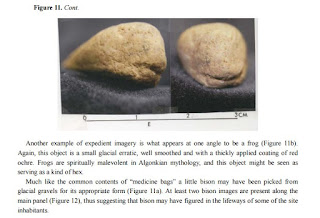“An unusual finding is what is being
called “expedient imagery”. Sustaining the theory that the occupations relate
to the rock art, these objects consist of only slightly modified natural stones
resembling animals (Fig. 8) and birds (Fig. 9), and possibly a phallus. It
would appear that these were selected for what they appeared to be and possibly
used in rituals pertaining to nearby rock art. All of them were found in secure
stratigraphic positions. One of them was cloven so as to lay flat (Fig. 9).
Also on the engraved panel, there is a quartz vein thought by some to resemble
an “eagle”.
The Hensler Petroglyph Site (47 CO 461): an early engraving site in the
North American Mid-Continent ~ Jack Steinbring
{STEINBRING J. 2012. — The Hensler Petroglyph Site (47 CO 461): an early
engraving site in the North American Mid-Continent. In: CLOTTES J. (dir.), L’art
pléistocène dans le monde / Pleistocene art of the world / Arte pleistoceno en
el mundo, Actes du Congrès IFRAO, Tarascon-sur-Ariège, septembre 2010,
Symposium « Art pléistocène dans les Amériques ». N° spécial de Préhistoire,
Art et Sociétés, Bulletin de la Société Préhistorique Ariège-Pyrénées,
LXV-LXVI, 2010-2011, CD: p. 599-606.}
“Linkage to the engraved panel may be made
in general by the finding of what we call “expedient imagery” (Figure 11). As
the name implies this is imagery which occurs in nature. An object, usually of
stone, is collected for use in some kind of ritual act. It may have a shape
akin to one that might be needed. Collection and use of objects like this is
not uncommon among aboriginal populations of North America. In the case at
Hensler, the first of these to be encountered in the excavations is a form
resembling a bird or possibly a reptile (Figure 11c). The piece was recovered
at level 8 and was flat on the surface. In fact, this specimen is cloven (the
other piece missing) so that it might remain stable on the ground. The
underside of this piece is rough from the detachment, not smooth like the top.
Its orientation was consistent with Mid-winter sunset. The object is a
glacially transported and abraded piece, having only slight embellishment at
the “eye.” It may well have remained in the location of its discovery since it
functioned there on the living floor…”





No comments:
Post a Comment